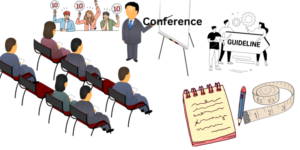Organizing and Getting Publisher Support for a Successful Conference
Conference are platforms where researchers, experts, and professionals come together to share their knowledge, ideas, and findings. These events cover a wide range of topics and provide an opportunity for participants to network and exchange ideas. Conferences often feature presentations, keynote speeches, panel discussions, and workshops.
Organizing a conference can be a challenging task, but with careful planning and execution, it can be a rewarding and successful event. Here’s a simplified guide on how to organize a conference:

Define Your Conference Goals:
Clearly outline the purpose, objectives, and target audience for your conference. What do you hope to achieve with this event? Who are you trying to reach? What topics will be covered?
Assemble a Planning Committee:
Form a team with diverse skills and expertise in event planning, marketing, publishing, logistics, and finance. Assign specific roles and responsibilities to each team member.
Set a Comprehensive Budget:
Create a detailed budget that includes all anticipated expenses, such as venue rental, catering, speaker fees, and marketing costs. Identify potential revenue sources, such as registration fees, sponsorships, and grants.
Choose a Suitable Date and Venue:
Select a date and location that are convenient for attendees and align with the conference’s theme. Consider factors like availability, accessibility, and potential conflicts with other events.
Secure Funding:
Research and explore various funding options, including registration fees, sponsorships, grants, and partnerships. Start seeking financial support early in the planning process.
Develop a Engaging Conference Program:
Create a comprehensive agenda that includes keynote speakers, panel discussions, workshops, and other sessions. Invite experienced and knowledgeable professionals to participate.
Publication Support for Conferences:
Conference publication involves managing the submission, review, and publication of conference papers and proceedings. Here are the key steps involved in the publication side of a conference:
Create Online Submission System:
Set up an online platform for authors to submit their papers, abstracts, or other contributions. Ensure the system is user-friendly and provides clear submission guidelines.
Manage Abstract Submission and Review:
Establish a process for authors to submit abstracts for presentations or papers. Implement a peer-review process to evaluate the quality and suitability of submissions.
Implement Peer-Review Process:
Appoint experts in the conference’s field to review submissions. Maintain transparency in the review process and provide timely feedback to authors.
Notify Authors about Acceptance or Rejection:
Inform authors about the acceptance or rejection of their submissions. Provide constructive feedback to authors if their work is not accepted.
Allow Authors to Revise Submissions:
If necessary, allow authors to revise their submissions based on reviewer feedback. Provide clear deadlines for revisions.
Coordinate Publication Process:
Appoint a publication chair or committee responsible for overseeing the publication process, including paper formatting, copyright, and proceedings preparation.
Provide Formatting Guidelines:
Issue detailed formatting guidelines to authors, including templates, citation styles, page limits, and specific requirements for the conference proceedings.
Address Copyright and Licensing:
Determine copyright and licensing terms for papers. Authors may need to transfer copyright or provide a specific license for their work to be included in the proceedings.
Organize Proceedings Production:
Work with a publisher or prepare the proceedings for online or print publication. Ensure the final product meets quality standards.
Archive and Index Proceedings:
Determine how and where the proceedings will be archived and indexed. This may involve databases, libraries, conference websites, or digital repositories.
Set Publication Schedule:
Establish a timeline for publishing and distributing the proceedings to align with the conference date and expectations of authors and attendees.
Determine Access and Distribution:
Decide whether the proceedings will be open access, available only to registered conference attendees, or require purchase or subscription. Ensure accessibility for attendees and the broader academic community.
Assign Digital Object Identifiers (DOIs):
Assign DOIs (Digital Object Identifiers) to individual papers or the proceedings as a whole for effective citation and indexing in academic databases.
Maintain Clear Communication:
Maintain open and timely communication with authors throughout the publication process. Address any questions or concerns promptly.
Communicate with Authors Effectively:
Stay in touch with authors throughout the publication process. Address their questions and concerns promptly.
Form a Publication Support Team:
Establish a team to assist authors with technical issues and formatting questions. Provide guidance on any publication-related inquiries.
Evaluate and Plan for Future Conferences:
Assess the strengths and weaknesses of the current conference. Use these insights to improve future events.
Documentation and Publication Archives:
Share Conference Proceedings and Documentation. Consider publishing conference proceedings for wider dissemination. Share documentation with attendees and the broader community.
Maintain Records and Archives:
Keep records of all publications and materials related to the conference. These records can serve as valuable resources for future reference.
Post-Conference Engagement:
Send thank-you notes to speakers, sponsors, and attendees.
Organize post-conference events, webinars, or other activities to maintain engagement.
Currently Shanlax Organizers International Conferences Incollabration with Madurai Kamaraj University – India, Bharathiar University – India, Euro-Balkan University – North Macedonia – Europe, Shanlax Journals – India.
Please Visit: https://www.shanlaxjournals.in/conferences/



Add comment